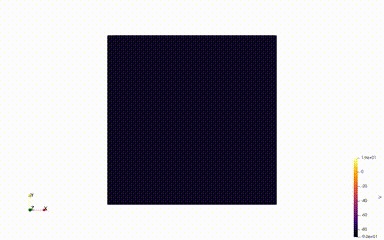Fibrotic region#
In this demo we will show how to model a fibrotic region in a 2D sheet of cardiac tissue. This demo is inspired by the demo in https://opencarp.org/documentation/examples/02_ep_tissue/21_reentry_induction
First we do the necessary imports
from pathlib import Path
import beat.single_cell
import dolfin
import numpy as np
try:
import ufl_legacy as ufl
except ImportError:
import ufl
import gotranx
import beat
We will define a function to define the conductivity tensor which will modify the conductivity tensor in the fibrotic region of the tissue and basically the the conductivities to \(10^{-7}\) in these elements.
def define_conductivity_tensor(
chi,
f0,
V_dg,
indices,
g_il,
g_it,
g_el,
g_et,
):
s_l, s_t = beat.conductivities.get_harmonic_mean_conductivity(
chi=chi, g_il=g_il, g_it=g_it, g_el=g_el, g_et=g_et
)
s_l_func = dolfin.Function(V_dg)
s_l_func.vector()[:] = s_l
s_l_func.vector()[indices] = 1e-7
s_t_func = dolfin.Function(V_dg)
s_t_func.vector()[:] = s_t
s_t_func.vector()[indices] = 1e-7
return s_l_func * ufl.outer(f0, f0) + s_t_func * (
ufl.Identity(2) - ufl.outer(f0, f0)
)
Now just define some general parameters for the simulation
results_folder = Path("results-fibrotic-region")
save_every_ms = 1.0
dimension = 2
transverse = False
# Increase this to see more interesting dynamics
end_time = 2.0
dt = 0.05
save_freq = round(save_every_ms / dt)
overwrite = False
stim_amp = 50_000.0
mesh_unit = "cm"
dx = 0.4 * beat.units.ureg("mm").to(mesh_unit).magnitude
L = 5.0 * beat.units.ureg("cm").to(mesh_unit).magnitude
data = beat.geometry.get_2D_slab_geometry(
Lx=L,
Ly=L,
dx=dx,
transverse=transverse,
)
print("Running model")
# # Load the model
model_path = Path("courtemanche_ramirez_nattel_1998.py")
if not model_path.is_file():
here = Path.cwd()
ode = gotranx.load_ode(
here / ".." / "odes" / "courtemanche_ramirez_nattel_1998.ode"
)
code = gotranx.cli.gotran2py.get_code(
ode, scheme=[gotranx.schemes.Scheme.forward_generalized_rush_larsen]
)
model_path.write_text(code)
import courtemanche_ramirez_nattel_1998
model = courtemanche_ramirez_nattel_1998.__dict__
Running model
2025-07-02 20:59:12 [info ] Load ode /__w/fenics-beat/fenics-beat/demos/../odes/courtemanche_ramirez_nattel_1998.ode
2025-07-02 20:59:13 [info ] Num states 21
2025-07-02 20:59:13 [info ] Num parameters 45
# Define model parameters for conductivities
conductivities = beat.conductivities.default_conductivities("Niederer")
# and the membrane capacitance
C_m = 1.0 * beat.units.ureg("uF/cm**2")
# Gather the defails initial states and parameters and set the stimulus amplitude to zero as this will be provided at the PDE level
fun = model["forward_generalized_rush_larsen"]
y = model["init_state_values"]()
time = dolfin.Constant(0.0)
parameters = model["init_parameter_values"](stim_amplitude=0.0)
# Next we define the point where we want to stimulate and choose a small region close to the left boundary
subdomain_data = dolfin.MeshFunction("size_t", data.mesh, data.mesh.topology().dim())
subdomain_data.set_all(0)
marker = 1
dolfin.CompiledSubDomain("x[0] < 2*dx", dx=dx).mark(subdomain_data, 1)
dolfin.File("subdomain_data.pvd") << subdomain_data
and define the stimulus to stimulate every 350 ms with a duration of 5 ms
I_s = beat.stimulation.define_stimulus(
chi=conductivities["chi"],
mesh=data.mesh,
mesh_unit=mesh_unit,
time=time,
start=5.0,
duration=5.0,
amplitude=stim_amp,
PCL=350.0,
subdomain_data=subdomain_data,
marker=marker,
)
Next we will define the fibrotic region is defined as a region in the center of radius 1.42 cm, i.e
fibrosis = dolfin.MeshFunction("size_t", data.mesh, data.mesh.topology().dim())
fibrosis.set_all(0)
marker = 1
dolfin.CompiledSubDomain(
"std::pow((x[0] - L/2),2) + std::pow((x[1] - L/2), 2) < std::pow(1.42, 2)", L=L
).mark(fibrosis, marker)
Inside this region we will have 70% of the tissue with reduced conductance for the g_K1, g_Na and g_Ca_L and the remaining 30% will have a conductivity of \(10^{-7}\).
We first find the indices and make 70/30 split
indices = np.where(fibrosis.array() == 1)[0]
np.random.shuffle(indices)
N = len(indices)
indices1 = indices[: int(N * 0.7)]
indices2 = indices[int(N * 0.7) :]
We define a function space for the parameters (at the elements and nodes)
V_dg = dolfin.FunctionSpace(data.mesh, "DG", 0)
V_ode = dolfin.FunctionSpace(data.mesh, "Lagrange", 1)
parameters_ode = np.zeros((len(parameters), V_ode.dim()))
parameters_ode.T[:] = parameters
Calling FFC just-in-time (JIT) compiler, this may take some time.
Calling FFC just-in-time (JIT) compiler, this may take some time.
And specify a 50% reduction in the g_K1 conductance
g_K1_index = model["parameter_index"]("g_K1")
# g_K1_index = model["parameter_index"]("scale_drug_IK1")
g_K1_value = parameters[g_K1_index]
g_K1_func = dolfin.Function(V_dg)
g_K1_func.vector()[:] = g_K1_value
g_K1_func.vector()[indices1] = g_K1_value * 0.5
parameters_ode[g_K1_index, :] = (
dolfin.interpolate(g_K1_func, V_ode).vector().get_local()
)
and 40% reduction in g_Na
g_Na_index = model["parameter_index"]("g_Na")
# g_Na_index = model["parameter_index"]("scale_drug_INa")
g_Na_value = parameters[g_Na_index]
g_Na_func = dolfin.Function(V_dg)
g_Na_func.vector()[:] = g_Na_value
g_Na_func.vector()[indices1] = g_Na_value * 0.6
parameters_ode[g_Na_index, :] = (
dolfin.interpolate(g_Na_func, V_ode).vector().get_local()
)
and a 50% reduction in g_Ca_L
g_CaL_index = model["parameter_index"]("g_Ca_L")
# g_CaL_index = model["parameter_index"]("scale_drug_ICaL")
g_CaL_value = parameters[g_CaL_index]
g_CaL_func = dolfin.Function(V_dg)
g_CaL_func.vector()[:] = g_CaL_value
g_CaL_func.vector()[indices1] = g_CaL_value * 0.5
parameters_ode[g_CaL_index, :] = (
dolfin.interpolate(g_CaL_func, V_ode).vector().get_local()
)
Finally we compute the conductivity tensor with the remaining non conductive tissue
M = define_conductivity_tensor(
V_dg=V_dg, indices=indices2, f0=data.f0, **conductivities
)
Now we are ready to set up the models
pde = beat.MonodomainModel(time=time, mesh=data.mesh, M=M, I_s=I_s, C_m=C_m.magnitude)
ode = beat.odesolver.DolfinODESolver(
v_ode=dolfin.Function(V_ode),
v_pde=pde.state,
fun=fun,
init_states=y,
parameters=parameters_ode,
num_states=len(y),
v_index=model["state_index"]("V"),
)
solver = beat.MonodomainSplittingSolver(pde=pde, ode=ode)
Calling FFC just-in-time (JIT) compiler, this may take some time.
Calling FFC just-in-time (JIT) compiler, this may take some time.
Calling FFC just-in-time (JIT) compiler, this may take some time.
Calling FFC just-in-time (JIT) compiler, this may take some time.
Calling FFC just-in-time (JIT) compiler, this may take some time.
Calling FFC just-in-time (JIT) compiler, this may take some time.
And solve
fname = (results_folder / "V.xdmf").as_posix()
beat.postprocess.delete_old_file(fname)
def save(t):
v = solver.pde.state.vector().get_local()
print(f"Solve for {t=:.2f}, {v.max() =}, {v.min() = }")
with dolfin.XDMFFile(data.mesh.mpi_comm(), fname) as xdmf:
xdmf.parameters["functions_share_mesh"] = True
xdmf.parameters["rewrite_function_mesh"] = False
xdmf.write_checkpoint(
solver.pde.state,
"V",
float(t),
dolfin.XDMFFile.Encoding.HDF5,
True,
)
t = 0.0
save_freq = int(1.0 / dt)
i = 0
while t < end_time + 1e-12:
# Make sure to save at the same time steps that is used by Ambit
if i % save_freq == 0:
save(t)
solver.step((t, t + dt))
i += 1
t += dt
Solve for t=0.00, v.max() =-81.17999999999998, v.min() = -81.1800000000001
Calling FFC just-in-time (JIT) compiler, this may take some time.
Calling FFC just-in-time (JIT) compiler, this may take some time.
Calling FFC just-in-time (JIT) compiler, this may take some time.
Solve for t=1.00, v.max() =-81.03796674971231, v.min() = -81.21042897252504
Solve for t=2.00, v.max() =-80.91191511605581, v.min() = -81.25071529621461

